Chinese Journal of Computational Physics ›› 2022, Vol. 39 ›› Issue (2): 127-142.DOI: 10.19596/j.cnki.1001-246x.8388
• Review Article • Next Articles
Wenjuan LYU1( ), Binbing WU1(
), Binbing WU1( ), Shiwei LIU2, Hao DUAN3, Jie LIU1,*(
), Shiwei LIU2, Hao DUAN3, Jie LIU1,*( )
)
Received:2021-04-28
Online:2022-03-25
Published:2022-06-24
Contact:
Jie LIU
Wenjuan LYU, Binbing WU, Shiwei LIU, Hao DUAN, Jie LIU. Progress in the Study of Deuteron-Triton Fusion Cross Sections in Superintense Laser Fields[J]. Chinese Journal of Computational Physics, 2022, 39(2): 127-142.
Add to citation manager EndNote|Ris|BibTeX
URL: http://www.cjcp.org.cn/EN/10.19596/j.cnki.1001-246x.8388

Fig.1 Partition diagrams of potential-distance between two charged nuclei with relative kinetic energy ε (U0 is the depth of potential well. rn and rmin are the nuclear contact radius and the classical turning point, respectively. As the distance between the two nuclei gets closer and closer, they will go through three processes (a) wave packet contact process, (b) tunneling process and (c) fusion process in turn, and finally fuse with a certain probability.)
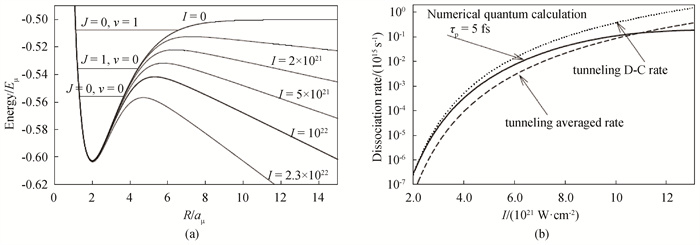
Fig.3 (a) Potential energy surfaces of a ddμ- molecular ion in a range of static electric fields plotted as an intensity of a laser pulse with same electric field amplitude (Eμ=5.472 3 keV, aμ=0.263×10-12 m); (b) ddμ- dissociation rate versus the field strength of the sample[52]
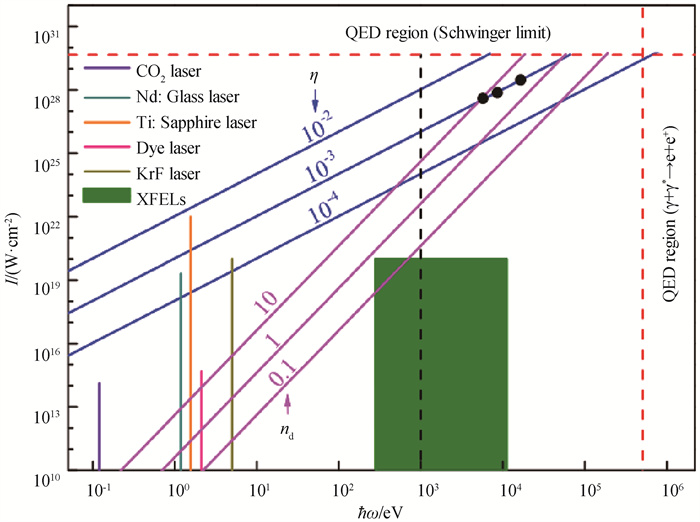
Fig.4 Phase diagram of laser parameters of currently achievable lasers (The vertical dashed black line represents a laser frequency of 1 keV. The solid blue lines denote η =10-2, 10-3 and 10-4. The solid pink lines denote nd= 0.1, 1, and 10. The black points are three typical laser parameters. Corresponding dimensionless parameters are nd= 3, 6, 9.[8])
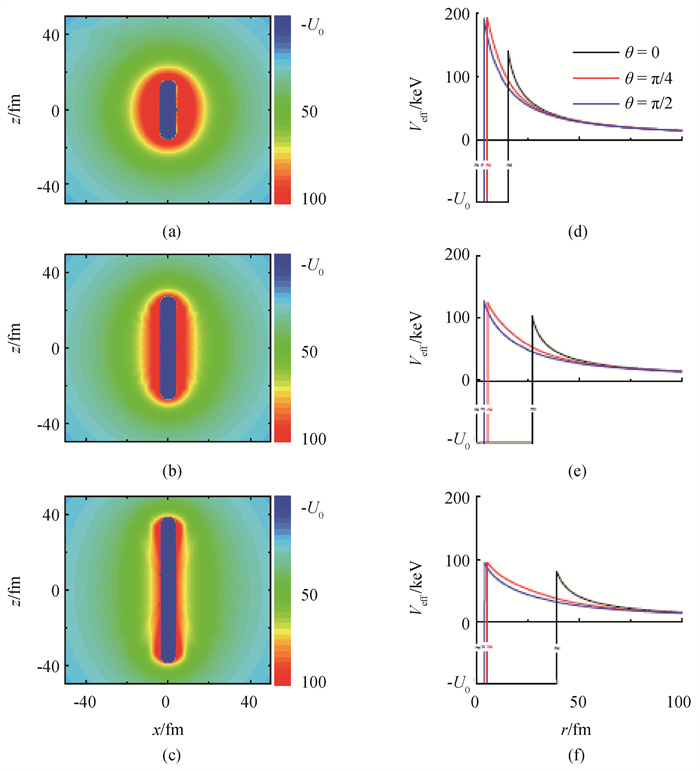
Fig.5 The effective potential is rotational symmetry with respect to z axis. (a)-(c) Contour plots on x-z section of the effective potential at nd=3, 6, 9, respectively; (The blue areas represent the section of inner region Din.)(d)-(f) Veff at different angles (θ=0, π/4, π/2) with respect to nd[8]
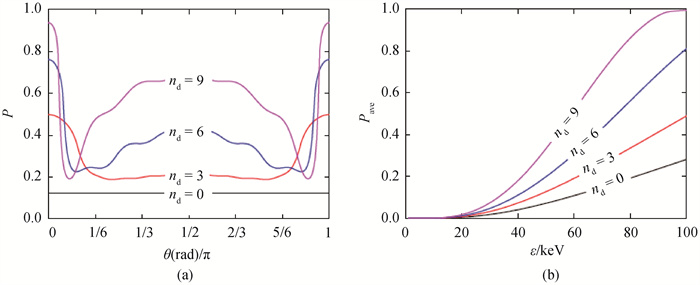
Fig.6 At nd=0, 3, 6, 9, (a) angle-dependent penetrability for collision energy of ε=64 keV; (b) angle-averaged penetrability versus collision energy[8]
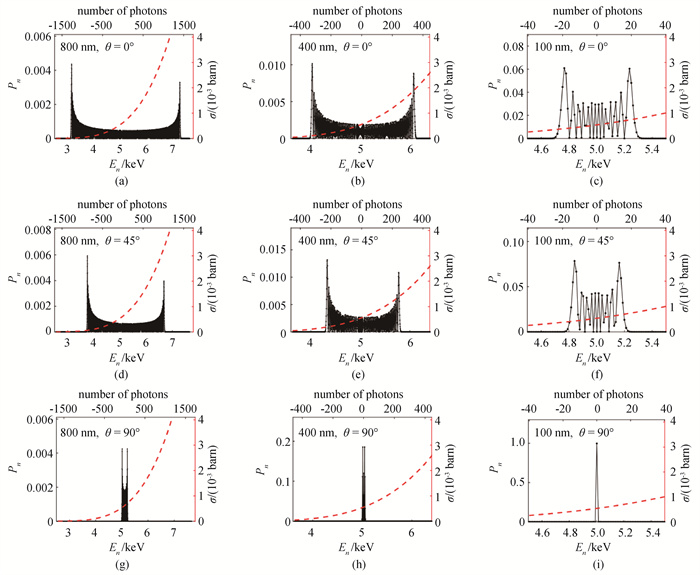
Fig.8 Probability distributions of particles that incident at different angles (θ = 0°, 45°, 90°) under different wavelengths (800 nm, 400 nm, 100 nm) of lasers with intensity 1020 W·cm-2 and corresponding fusion cross sections[53] (red curves)

Fig.9 Angle-averaged fusion cross sections at different laser intensities and wavelengths (The horizontal dot lines represent fusion cross sections without laser field[53].)
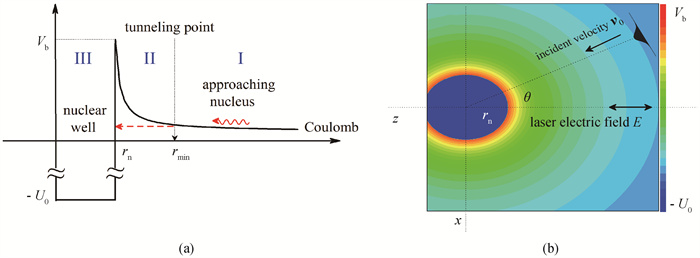
Fig.10 (a) The process of DT fusion is divided into three regions, Region Ⅰ: classical motion; Region Ⅱ: quantum tunneling; Region Ⅲ: nuclear fusion; (b) A schematic of classical simulations with an initial Gaussian distribution[54]
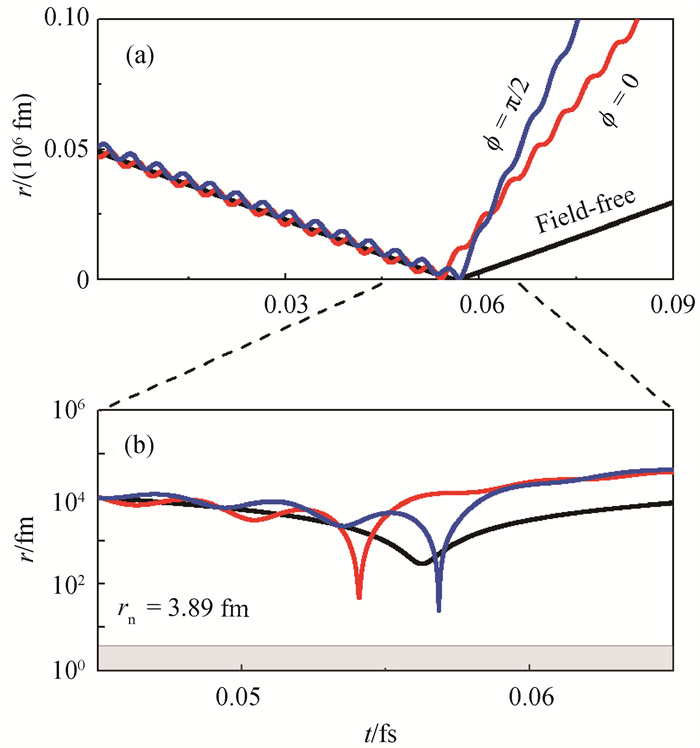
Fig.11 (a) Typical classical trajectories of a DT collision driven by laser field at ε=5 keV with different initial laser phases; (b) Zoom-in of the trajectory in (a) (Laser parameters are I=1024 W·cm-2, $\hbar \omega$ =10 eV.)

Fig.13 13 (a)-(b) Total fusion cross section with various laser intensities and frequencies obtained with the SC method (red circles). Others are presented for comparison: the KH results (olive lines) and the VSA results (blue dotted lines). The initial incident energy ε=1 keV. (c)-(d) Phase diagram of the effective region of laser-field-enhanced DT fusion cross sections at different initial energies
| 1 |
盛新志, 娄淑琴. 激光原理[M]. 第2版 北京: 清华大学出版社, 2015: 1- 12.
|
| 2 |
DOI |
| 3 |
周炳琨, 高以智, 陈倜嵘, 等. 激光原理[M]. 北京: 国防工业出版社, 2009: 210- 243.
|
| 4 |
DOI |
| 5 |
DOI |
| 6 |
李儒新. 上海超强超短激光实验装置研制进展[J]. 强激光与粒子束, 2020, 32 (1): 011002.
|
| 7 |
DOI |
| 8 |
DOI |
| 9 |
|
| 10 |
刘杰, 夏勤智, 傅立斌. 强激光场中的原子、分子与团簇[M]. 北京: 科学出版社, 2014: 1- 234.
|
| 11 |
|
| 12 |
|
| 13 |
|
| 14 |
|
| 15 |
|
| 16 |
DOI |
| 17 |
李子良, 努尔曼古丽·阿卜杜克热木, 谢柏松. 超强场下真空产生正负电子对的动理学方法研究及其进展[J]. 物理学进展, 2016, 36 (5): 129- 156.
|
| 18 |
DOI |
| 19 |
谢柏松, 李子良, 唐琐, 等. 超强场下的正负电子对产生[J]. 物理, 2017, 46 (11): 713- 720.
DOI |
| 20 |
DOI |
| 21 |
|
| 22 |
|
| 23 |
|
| 24 |
DOI |
| 25 |
DOI |
| 26 |
SCHWOERER H, BELEITES B, MAGILL J. Lasers and nuclei: Applications of ultrahigh intensity lasers in nuclear science[M]. WANG N Y, Transl. Harbin: Harbin Engineering University Press, 2019: 3-102.
|
| 27 |
王乃彦. 激光核物理[J]. 物理, 2008, 37 (9): 621- 624.
DOI |
| 28 |
马余刚. 原子核物理新进展[M]. 上海: 上海交通大学出版社, 2020: 377- 397.
|
| 29 |
DOI |
| 30 |
DOI |
| 31 |
DOI |
| 32 |
DOI |
| 33 |
DOI |
| 34 |
DOI |
| 35 |
DOI |
| 36 |
卢希庭, 江栋兴, 叶沿林. 原子核物理[M]. 第2版 北京: 原子能出版社, 2000: 97- 293.
|
| 37 |
DOI |
| 38 |
|
| 39 |
|
| 40 |
|
| 41 |
DOI |
| 42 |
DOI |
| 43 |
DOI |
| 44 |
DOI |
| 45 |
DOI |
| 46 |
DOI |
| 47 |
DOI |
| 48 |
DOI |
| 49 |
DOI |
| 50 |
|
| 51 |
|
| 52 |
|
| 53 |
DOI |
| 54 |
DOI |
| 55 |
刘士炜. 激光场中粒子碰撞的经典轨道动力学研究[D]. 北京: 中国工程物理研究院研究生院, 2020.
|
| 56 |
|
| 57 |
DOI |
| 58 |
DOI |
| 59 |
DOI |
| 60 |
DOI |
| 61 |
DOI |
| 62 |
|
| 63 |
DOI |
| [1] | Libo ZHOU, Tao YE, Jia WANG, Weili SUN. A Theoretical Analysis of Generalized Reduced R-Matrix of 4He System [J]. Chinese Journal of Computational Physics, 2022, 39(6): 631-640. |
| Viewed | ||||||
|
Full text |
|
|||||
|
Abstract |
|
|||||
Copyright © Chinese Journal of Computational Physics
E-mail: jswl@iapcm.ac.cn
Supported by Beijing Magtech Co., Ltd.
